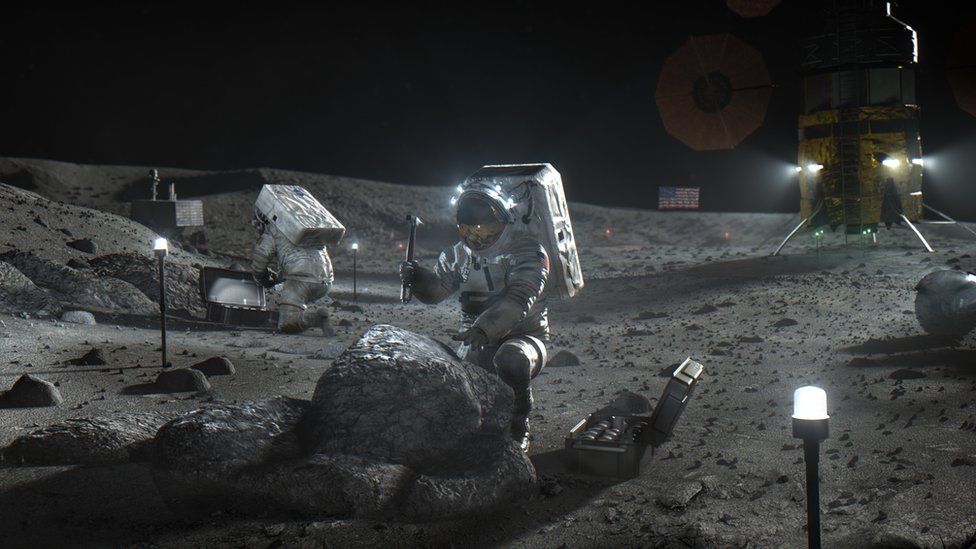“‘If the idea of mining asteroid seems outlandish,’ Vescovo argues, ‘many technological breakthroughs – the Wright brothers' first manned flight, for example – have likewise carried the same burden. Until, that is, they actually happen. The astrophysicist Neil deGrasse Tyson has said that the first trillionaire will come through asteroid mining.’” Victor Vescovo (One of AstroForge’s main investors and the explorer who built a submersible that in 2019 made him the first person to visit the bottom of all five oceans.)
So, I think there’s a reasonable chance mining asteroids will one day be a reality. We’re completely unamazed today, of incredibly wealthy people taking short trips to the “bottom ledge” of space – even actors who’ve PRETENDED to live and work in space, (“No, I'm from Iowa, I only work in space.”), have actually ridden on top of a rocket.
“By April 5, 2025, a total of 13 private visitors, known as spaceflight participants, from seven countries have visited the International Space Station, according to NASA. International Space Station Visitors: 283 individuals from 23 countries have visited.”
“As of March 2025, 682 people have reached the altitude of space according to the FAI definition of the boundary of space, and 721 people have reached the altitude of space according to the USAF definition.” (https://www.nasa.gov/international-space-station/space-station-visitors-by-country/)
While the number of people who’ve gone into space is hardly staggering, the KINDS of people who have gone has increased – there’s even a way to go into space as a “tourist”!
How long has it taken for this number to climb from one (Yuri Gagarin (1934–1968), First person in space. — Soviet Union Vostok 1, 1961) to Humans having a space station that has been occupied continually for 25 years, and hosted 721 people who have BEEN TO SPACE?
That’s at TINY number of years. If I wanted to, I could probably calculate the actual Rate of Growth of Space Occupation/Visitation Over Time…but I that’s pretty much beyond my capabilities in math (calculus????) or whatever.
But GIVEN that, let’s see what the rate of growth and in particular, mining of the “new” world that Europeans started mining:
USA is 250 years old in 2025 AD.
Earliest known metalworking: 5000 years before the Roman calendar.
“The earliest known metalworking in North America began some 7,000 years ago, when Native Americans mined copper in hand-dug pits on an isolated peninsula in the Midwest. Remains of this massive deposit and the booming industry that grew around it are now part of a national historical park.”
The European invasion started in 1000 CE, the Vikings being the first perpetrato
“The oldest-known mine on archaeological record is the Ngwenya Mine in Eswatini (Swaziland), which radiocarbon dating shows to be about 43,000 years old… The oldest-known mine on archaeological record is the Ngwenya Mine in Eswatini (Swaziland), which radiocarbon dating shows to be about 43,000 years old. At this site Paleolithic humans mined hematite to make the red pigment ochre. Mines of a similar age in Hungary are believed to be sites where Neanderthals may have mined flint for weapons and tools.” ( https://en.wikipedia.org/wiki/Mining)
The Dawn of Mining to the Asteroid Age was about 40,000 years (for the ease of calculations). Some 1600 generations; let’s say 1000 (a generation in prehistoric southern Africa was substantially SHORTER than a generation of 21st Century (48th Century China; 21st Century in India (though it’s 2082); Reiwa 7 in Japan)…so, let’s give us (ONLY for the sake of argument!) from the establishment of the OLDEST known Earth Human mine it took 1000 generations.
But THAT included the development of Human civilization from the invention of cloth and leather to expanding Human occupation of more and more hostile environments. THAT part of our history is past. Let’s take it from the inauguration of mechanized mining: “…Water wheels date to the Roman period and were used to grind grain and lift irrigation water. Water-powered bellows were in use on blast furnaces in China in 31 AD.[4] By the 13th century, water wheels powered sawmills[5] and trip hammers, to pull cloth and pound flax and later cotton rags into pulp for making paper. Trip hammers are shown crushing ore in De re Metallica (1555).” (https://en.wikipedia.org/wiki/Mechanization)
So pulling it all together, it took some 2000 years to raise Human mining from pickaxes, water wheels, and charcoal fires, to automated, computerized digging, transporting, and processing, to a space-going civilization. Let’s take the “automated, transporting, and processing” as a given – BUT, add digging, transporting, and processing IN A VACUUM and add 1000 more years. That’s NOT to say that we can move FASTER than the civilization 2000 years ago; but let’s just say (1000-500 or 750 year) or somewhere between 2025 and 2775 as a full-blown space-occupying civilization. I’m NOT talking about Humans on Pluto or anything; but there will certainly be large habitats between Earth and Mars (where many ASTEROIDS are); probably islands of Humans between Earth and Venus – who KNOWS what’s on the surface there (well, WE do, but the days are brutal because the day is nearly as long a its year, and everything made on Earth pretty much disintegrates because of TRULY acid rain, no real sunlight, and perpetual cloudiness…
Likely there will be “islands” in space – asteroids mined out and abandoned, then gengineered plants cultivated on the interior under the light of self-replicating-and-repairing sunlamps…with the requisite adaptations to a new environment…leading (inevitably to revolution and a break from Earth and the birth of a “frontier society” akin to the American West, Russian Siberia, British Australia, and China’s Xinjiang province with its mosques, steppes, sand dunes, and majority population (47%) of Uighur, dubbed by “official Chinese”, as “a place which is luoho and luan, or “backward and chaotic” (sounds like the wild, wild West to me!).
Me? I’d lay my bets on SOONER than the 28th Century…
Today’s Source: https://www.bbc.com/future/article/20250320-how-close-are-we-really-to-mining-asteroids
Other data: https://en.wikipedia.org/wiki/List_of_space_travelers_by_nationality
Foundational Resource: (A general Wikipedia post detailing what the authors currently know about asteroid mining: https://en.wikipedia.org/wiki/Asteroid_mining)
Noted Resources: https://en.wikipedia.org/wiki/List_of_asteroid_close_approaches_to_Earth, https://www.pharostribune.com/news/local_news/article_7fcd3ea5-3c14-533f-a8d5-9bf629922f34.html, https://www.fool.com/investing/2022/04/29/like-asteroid-mining-be-careful-what-you-wish-for/, https://www.nps.gov/wrbr/learn/historyculture/theroadtothefirstflight.htm, https://hackaday.com/2019/03/27/extraterrestrial-excavation-digging-holes-on-other-worlds/, https://www.planetary.org/space-missions/every-small-worlds-mission
Interesting Stuff The Might Apply To Mining Asteroids: https://www.bbc.com/news/articles/cgej7gzg8l0o
So, I think there’s a reasonable chance mining asteroids will one day be a reality. We’re completely unamazed today, of incredibly wealthy people taking short trips to the “bottom ledge” of space – even actors who’ve PRETENDED to live and work in space, (“No, I'm from Iowa, I only work in space.”), have actually ridden on top of a rocket.
“By April 5, 2025, a total of 13 private visitors, known as spaceflight participants, from seven countries have visited the International Space Station, according to NASA. International Space Station Visitors: 283 individuals from 23 countries have visited.”
“As of March 2025, 682 people have reached the altitude of space according to the FAI definition of the boundary of space, and 721 people have reached the altitude of space according to the USAF definition.” (https://www.nasa.gov/international-space-station/space-station-visitors-by-country/)
While the number of people who’ve gone into space is hardly staggering, the KINDS of people who have gone has increased – there’s even a way to go into space as a “tourist”!
How long has it taken for this number to climb from one (Yuri Gagarin (1934–1968), First person in space. — Soviet Union Vostok 1, 1961) to Humans having a space station that has been occupied continually for 25 years, and hosted 721 people who have BEEN TO SPACE?
That’s at TINY number of years. If I wanted to, I could probably calculate the actual Rate of Growth of Space Occupation/Visitation Over Time…but I that’s pretty much beyond my capabilities in math (calculus????) or whatever.
But GIVEN that, let’s see what the rate of growth and in particular, mining of the “new” world that Europeans started mining:
USA is 250 years old in 2025 AD.
Earliest known metalworking: 5000 years before the Roman calendar.
“The earliest known metalworking in North America began some 7,000 years ago, when Native Americans mined copper in hand-dug pits on an isolated peninsula in the Midwest. Remains of this massive deposit and the booming industry that grew around it are now part of a national historical park.”
The European invasion started in 1000 CE, the Vikings being the first perpetrato
“The oldest-known mine on archaeological record is the Ngwenya Mine in Eswatini (Swaziland), which radiocarbon dating shows to be about 43,000 years old… The oldest-known mine on archaeological record is the Ngwenya Mine in Eswatini (Swaziland), which radiocarbon dating shows to be about 43,000 years old. At this site Paleolithic humans mined hematite to make the red pigment ochre. Mines of a similar age in Hungary are believed to be sites where Neanderthals may have mined flint for weapons and tools.” ( https://en.wikipedia.org/wiki/Mining)
The Dawn of Mining to the Asteroid Age was about 40,000 years (for the ease of calculations). Some 1600 generations; let’s say 1000 (a generation in prehistoric southern Africa was substantially SHORTER than a generation of 21st Century (48th Century China; 21st Century in India (though it’s 2082); Reiwa 7 in Japan)…so, let’s give us (ONLY for the sake of argument!) from the establishment of the OLDEST known Earth Human mine it took 1000 generations.
But THAT included the development of Human civilization from the invention of cloth and leather to expanding Human occupation of more and more hostile environments. THAT part of our history is past. Let’s take it from the inauguration of mechanized mining: “…Water wheels date to the Roman period and were used to grind grain and lift irrigation water. Water-powered bellows were in use on blast furnaces in China in 31 AD.[4] By the 13th century, water wheels powered sawmills[5] and trip hammers, to pull cloth and pound flax and later cotton rags into pulp for making paper. Trip hammers are shown crushing ore in De re Metallica (1555).” (https://en.wikipedia.org/wiki/Mechanization)
So pulling it all together, it took some 2000 years to raise Human mining from pickaxes, water wheels, and charcoal fires, to automated, computerized digging, transporting, and processing, to a space-going civilization. Let’s take the “automated, transporting, and processing” as a given – BUT, add digging, transporting, and processing IN A VACUUM and add 1000 more years. That’s NOT to say that we can move FASTER than the civilization 2000 years ago; but let’s just say (1000-500 or 750 year) or somewhere between 2025 and 2775 as a full-blown space-occupying civilization. I’m NOT talking about Humans on Pluto or anything; but there will certainly be large habitats between Earth and Mars (where many ASTEROIDS are); probably islands of Humans between Earth and Venus – who KNOWS what’s on the surface there (well, WE do, but the days are brutal because the day is nearly as long a its year, and everything made on Earth pretty much disintegrates because of TRULY acid rain, no real sunlight, and perpetual cloudiness…
Likely there will be “islands” in space – asteroids mined out and abandoned, then gengineered plants cultivated on the interior under the light of self-replicating-and-repairing sunlamps…with the requisite adaptations to a new environment…leading (inevitably to revolution and a break from Earth and the birth of a “frontier society” akin to the American West, Russian Siberia, British Australia, and China’s Xinjiang province with its mosques, steppes, sand dunes, and majority population (47%) of Uighur, dubbed by “official Chinese”, as “a place which is luoho and luan, or “backward and chaotic” (sounds like the wild, wild West to me!).
Me? I’d lay my bets on SOONER than the 28th Century…
Today’s Source: https://www.bbc.com/future/article/20250320-how-close-are-we-really-to-mining-asteroids
Other data: https://en.wikipedia.org/wiki/List_of_space_travelers_by_nationality
Foundational Resource: (A general Wikipedia post detailing what the authors currently know about asteroid mining: https://en.wikipedia.org/wiki/Asteroid_mining)
Noted Resources: https://en.wikipedia.org/wiki/List_of_asteroid_close_approaches_to_Earth, https://www.pharostribune.com/news/local_news/article_7fcd3ea5-3c14-533f-a8d5-9bf629922f34.html, https://www.fool.com/investing/2022/04/29/like-asteroid-mining-be-careful-what-you-wish-for/, https://www.nps.gov/wrbr/learn/historyculture/theroadtothefirstflight.htm, https://hackaday.com/2019/03/27/extraterrestrial-excavation-digging-holes-on-other-worlds/, https://www.planetary.org/space-missions/every-small-worlds-mission
Interesting Stuff The Might Apply To Mining Asteroids: https://www.bbc.com/news/articles/cgej7gzg8l0o


No comments:
Post a Comment